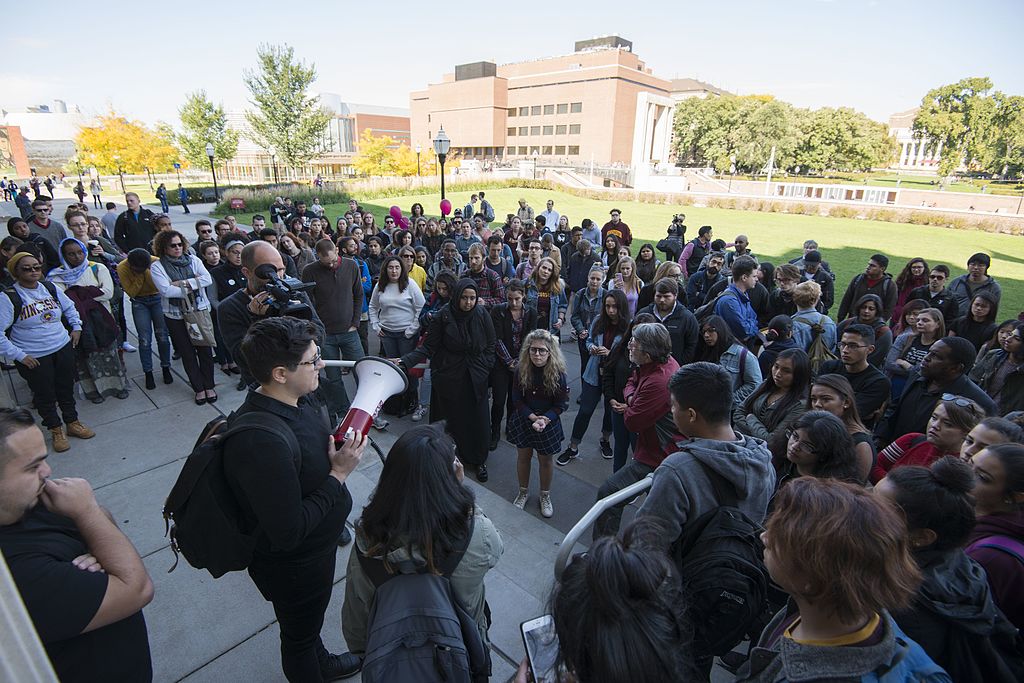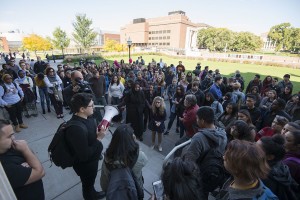The Psychology of Social Justice
 University of Minnesota students protest hate speech https://goo.gl/zi1Lq3
University of Minnesota students protest hate speech https://goo.gl/zi1Lq3

In the past few years, university campuses have been inundated with memes about safety, social justice, microaggresions and inclusiveness. The new champion of the ‘oppressed’ and the ‘marginalized’ is the Social Justice Warrior. This movement, propelled largely by students, emerged sometime in 2013. Its aim is to eliminate words, ideas, and even whole areas of studies that may cause offence or psychological distress to students, especially among racial, sexual and religious minorities. Through fierce social media campaigning and clamorous public demonstration, these ‘Social Justice’ groups have made their presence felt on campus. Indeed, between summoning their professors to Equal Opportunity Commissions to atone for their ‘marginalizing’ content and getting ‘hateful’ speakers uninvited from special events, their impact on education and political culture has been startling. Armed with an ideology of extreme identity politics, these groups propound narratives about oppression, privilege, and injustice they view are pervading American society. With encouragement from their gender, cultural, and ethnic studies programs to become vocal advocates of these attitudes, some students have set out to change the world.
Interestingly, the largest movements that have taken place at schools have historically been the most liberal. Since 2000, there have been over 240 campaigns in U.S. universities to prevent public figures from appearing at campus events, most of them occurring after 2009. In October 2015, demands for a “safe space” during the Halloween Costume Controversy at Yale forced a lecturer to resign. At Brown, Missouri, and Yale, protests erupted, and ultimatums were foisted upon university presidents to change the “racist” policies of their schools. In Yale, there was a petition signed by over 50 Yale professors backing these students, most of whom hailed from gender studies, film studies and English departments. In response, most schools apportioned large sums of money, often between 50 and 100 million dollars, to help “create a just and inclusive campuses.” The particular strategies proposed for redressing injustice include more social justice and anti-racism training for students and staff, more diversity training, more stringent hate speech codes, and more reporting mechanisms for victims. It seems most of the support from faculty this movement has drawn is from the humanities department, where professors tend to be overwhelmingly left-wing. Two recent changes seem to explain the inability and unwillingness of professors to push back. First, there has been a notable rise in political polarization in the United States in the last few decades. Second, since the 1990s, the has been a ‘shift to the left‘ among university academics in the United States, with the proportion of left-wing professors rising from 42% to 60%, and the proportion of right-wing professors dropping from 18% to 13%. The ratio of left to right winged professors is six to one, and this disparity is most pronounced in humanities, where this ratio ranges between ten to one and twenty to one.
University of Toronto psychology Jordan Peterson and his colleagues have recently done research on the political psychology of left-wing authoritarianism and its enablers on the left. Through statistical analysis, they discovered the psychological underpinnings of the trait ‘political correctness (PC)’ in left-wing authoritarians, as well as the traits in mainstream leftists that explain their enabling of political correctness. They found that the rise in political correctness can be explained by two mutually supportive psychological profiles, PC authoritarianism, and PC egalitarianism. Both share the trait ‘agreeableness’ (generally present in liberals), a component of which is compassion, or a deep empathy for others (associated with a mother-child pair bond). Their differentiating elements are ‘orderliness,’ a general desire for simplicity or coherence in their worldview. PC authoritarians have this trait, while PC egalitarians do not. Moreover, authoritarians have a high disgust sensitivity (a precursor of intolerance to differing opinions), often an anxiety disorder (a contributor to general emotional distress), and a very low verbal cognitive ability. Most of these traits are shared by right-wing authoritarians. PC egalitarians on the other hand do not share any of these qualities. In fact, they are very high tolerant, and have a high verbal cognitive ability. PC egalitarianism was also predicted by a high degree of attentiveness to differences between individuals and groups, which is associated with a desire for inclusiveness and equality. It is said that both right-wing and left-wing authoritarians favour homogeneity in society, although the former want it achieved through exclusion, and the latter through inclusion. It is hypothesized that PC egalitarians – who are very high in compassion – perceive the emotional distress of authoritarians, and align with them politically as their ‘protectors.’ It may often be understood that such distress signals legitimate grievance or genuine cause for concern. Because they have a high verbal ability, they often create “post hoc justifications” for the policies of authoritarians, which include censorship, punitive justice, and ‘diversity training.’ Peterson concludes that this reaction – driven by empathy – has contributed to the atmosphere of so called ‘vindictive protectiveness’ we see on campus. The hyper-sensitivity, coupled with extreme egalitarianism, has served to shut down open debate on many issues, and allowed for the demonization of those who are non-compliant. This is true especially when it in any way concerns protected minority groups.
Two sociologists, Bradley Manning and Jason Campbell, recently wrote a paper on the origins of ‘microaggressions’ in American colleges. They describe it as having resulted from the second transition in moral culture. The first transition occurred in the 18th and 19th centuries, where societies moved away from an honour culture – where individuals earned their honour by avenging themselves against transgressors – to a culture of dignity. Here, violence was largely abandoned, and dignity was understood to be inherent in every individual. Minor transgressions were ignored, while major violations were now dealt within powerful social institutions. Throughout this period, administrative bodies were created to maintain order and justice. The second transition has brought a new shift to a culture of victimhood, in which people respond with extraordinary measures to even minor transgressions (as in the honour culture), although this time, with recourse to the powerful administrative bodies. Their conclusion was that in environments where such institutions are in abundance (and willing to punish opponents), and where egalitarianism and diversity are highly cherished norms, there are incentives for individuals to identify themselves as “fragile and aggrieved victims.” This is perhaps why the most vehement protests over these issues have occurred in the most progressive universities in America, such as Yale and Brown. NYU Psychologist Jonathan Haidt gives an excellent summary of this argument: “the key idea is that the new moral culture of victimhood fosters “moral dependence” and an atrophying of the ability to handle small interpersonal matters on one’s own. At the same time that it weakens individuals, it creates a society of constant and intense moral conflict as people compete for status as victims or defenders of victims.”
Haidt has also made an interesting argument regarding the phenomenon of concept creep. He maintains that where a narrative of distress, ‘triggering,’ and trauma takes hold, concepts used to describe these incidents become progressively more exaggerated. Words like ‘abuse’ and ‘violence’ are then inserted to bolster grievance claims and demonize opponents. Northwestern University’s professor Laura Kipnis wrote, “Emotional discomfort is [now] regarded as equivalent to material injury, and all injuries have to be remediated.” Students favour argumentation based on narrative rather than evidence, and engage in ad hominem attacks to discredit the character of the opponent instead of engaging with their actual argument.
In trying to identify the roots of this ‘moral panic,’ Haidt points to the increase in polarization between liberals and conservatives in the recent decades, coupled with a shift in childrearing practice. He argues that since cable TV became widespread in the 1980s, the public’s constant exposure to news coverage of a few high-profile child kidnappings has led to a sharp decline in the amount of time children spend outside unsupervised. Kids would no longer have to deal with difficult and even abusive interpersonal situations on their own because they had recourse to a higher authority. This, in turn, has fostered a learned dependence on an authority which has always been able and willing to punish. Immersed in this mentality, these children would enter college expecting a similar level of enforcement and so called “accountability” for transgressors – students and professors alike. In response, many professors have been purging their syllabi of potentially upsetting material, and some are even afraid to raise certain issues for fear of backlash. The “offensive” texts of Edward Said and Mark Twain are said to have no place in a classroom where the most sensitive students may be vulnerable to feeling “marginalized” or hurt by their content.
Jonathan Haidt has likened such movements to a new religion on campus, where “the most sacred things in the world is the victim… and we have blasphemy laws, if someone questions affirmative action… it is literally defined as a microagression.” He says that some have even associated questioning affirmative action to the Holocaust denial. Moreover, the validation of this so called ‘vindictive protectionism’ by university administrations has led to measures to increase ‘diversity training.’ Haidt also says that the measures the universities have promised to take will do more bad than good. He claims that the psychology literature on methods such as ‘diversity training’ ought to create misgivings about their efficacy and even desirability. It not only prepares students poorly for their later “professional life” and “intellectual engagement,” but actually teaches the exact patterns of thought that are characteristics of cognitive disorders. Some of these include catastrophizing, over-generalizing, and emotional reasoning. “A campus culture devoted to policing speech and punishing speakers is likely to engender patterns of thought that are surprisingly similar to those long identified by cognitive behavioural therapists as causes of depression and anxiety. The new protectiveness may be teaching students to think pathologically.”
The main problem posed by this ideology is that it constrains the primary and indispensable function of freedom of speech. This would be the forum of ideas it creates for intelligent debate aimed at solving prominent social and intellectual problems. Arguably, such an enterprise is meant to flourish most at a university. A professor writing anonymously for Vox said, “It’s not just that students refuse to countenance uncomfortable ideas – they refuse to engage them, period.” It is often said that a free exchange of ideas, coupled with democratic decision makings, is what keeps societies from devolving into violence over ideological differences. It is said Alfred North Whitehead once remarked: “the purpose of thinking is so that we can let our ideas die instead of us.” The movement created by the Social Justice Left is authoritarian in its nature and culturally Marxist in its aspirations. Arguably, the culture of political correctness amplified by the Social Justice Left movement empowered Donald Trump among the general public to an extent. Universities have historically been incubators for great intellectual movements and ideologies. It remains to be seen whether this will continue to hold true.
